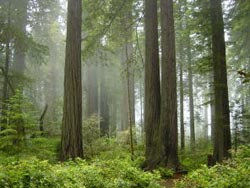Redwood trees reveal history of West Coast rain, fog, ocean conditions

Michael Schweppe / Flickr<br><br>Coastal redwoods in Northern California use fog as a water source, incorporating the molecules in their trunks.<br>
A University of Washington researcher has developed a way to use the trees as a window into coastal conditions, using oxygen and carbon atoms in the wood to detect fog and rainfall in previous seasons.
“This is really the first time that climate reconstruction has ever been done with redwoods,” said Jim Johnstone, who recently completed a postdoctoral position at the UW-based Joint Institute for the Study of the Atmosphere and the Ocean. He is corresponding author of a study published online Oct. 24 in the Journal of Geophysical Research-Biogeosciences.
While coastal redwoods are not the longest-lived trees on the West Coast, they do contain unique information about their foggy surroundings.
“Redwoods are restricted to a very narrow strip along the coastline,” Johnstone said. “They’re tied to the coastline, and they’re sensitive to marine conditions, so they actually may tell you more about what’s happening over the ocean than they do about what’s happening over land.”
The new study used cores from Northern California coastal redwoods to trace climate back 50 years. Weather records from that period prove the method is accurate, suggesting it could be used to track conditions through the thousand or more years of the redwoods’ lifetime.
Tree-ring research, or dendrochronology, typically involves a detailed look at a cross-section of a tree trunk. But the rings of a redwood are uneven and don’t always fully encircle the tree, making it a poor candidate for anything except detecting historic fires.
The new paper uses a painstaking approach that’s more like processing ice cores. It uses the molecules captured in the wood to sample the atmosphere of the past.
Most oxygen in Earth’s atmosphere has an atomic mass of 16, making it O-16, but a small percentage of oxygen is the heavier O-18 isotope. When seawater evaporates off the ocean to form clouds, some drops fall as rain over the ocean, and more of the heavier O-18 molecules rain out. The remaining drops that fall on land thus have a higher proportion of the lighter O-16 molecules.
Fog, on the other hand, forms near shore and blows on land where it drips down through the branches until the trees use it like rainwater.
By looking at the proportion of O-16 and O-18 in the wood from each season, the team was able to measure the contribution of fog and rain. They looked at the spring growth, from April to June, as well as the fall growth, from August to October. Researchers also analyzed carbon atoms to measure the total amount of moisture in the air.
“We actually have two indicators that we can use in combination to determine if a particular summer was foggy with a little rain, foggy with a lot of rain, and various combinations of the two,” Johnstone said.
Related research by Johnstone shows that the amount of West Coast fog is closely tied to the surface temperature of the ocean, so redwoods may be able to tell us something about the long-term patterns of ocean change, such as the Pacific Decadal Oscillation. Understanding of the natural variability cycles could also help to better distinguish natural and human-caused climate change.
“It’s possible that the redwoods could give us direct indication of how that’s worked over longer periods,” Johnstone said. “This is just a piece that contributes to that understanding in a pretty unique place.”
Johnstone conducted the research as part of his doctoral work at the University of California, Berkeley, where he was advised by co-author Todd Dawson. The other co-author is John Roden at Southern Oregon University. The research was funded by the National Science Foundation.
For more information, contact Johnstone at jajstone@gmail.com.
Media Contact
More Information:
http://www.uw.eduAll latest news from the category: Earth Sciences
Earth Sciences (also referred to as Geosciences), which deals with basic issues surrounding our planet, plays a vital role in the area of energy and raw materials supply.
Earth Sciences comprises subjects such as geology, geography, geological informatics, paleontology, mineralogy, petrography, crystallography, geophysics, geodesy, glaciology, cartography, photogrammetry, meteorology and seismology, early-warning systems, earthquake research and polar research.
Newest articles

Silicon Carbide Innovation Alliance to drive industrial-scale semiconductor work
Known for its ability to withstand extreme environments and high voltages, silicon carbide (SiC) is a semiconducting material made up of silicon and carbon atoms arranged into crystals that is…

New SPECT/CT technique shows impressive biomarker identification
…offers increased access for prostate cancer patients. A novel SPECT/CT acquisition method can accurately detect radiopharmaceutical biodistribution in a convenient manner for prostate cancer patients, opening the door for more…

How 3D printers can give robots a soft touch
Soft skin coverings and touch sensors have emerged as a promising feature for robots that are both safer and more intuitive for human interaction, but they are expensive and difficult…




















